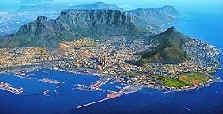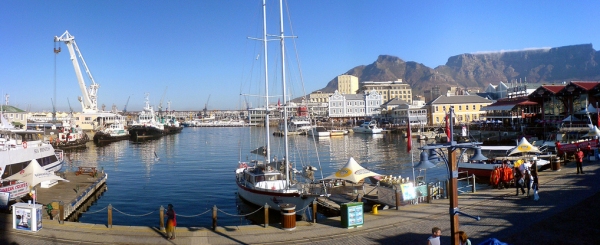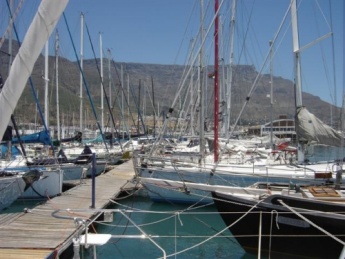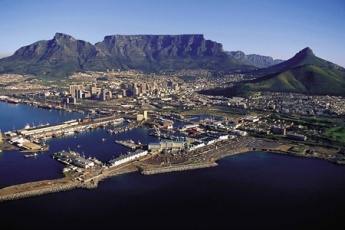Cape Town
From CruisersWiki
| Cape Town Port of Entry
| |
Cape Town is one of the highlights of the Cape of Good Hope Cruising Route. Cape Town is the second most populous city in South Africa, forming part of the metropolitan municipality of the City of Cape Town. It is the provincial capital of the Western Cape, as well as the legislative capital of South Africa, where the National Parliament and many government offices are located. Cape Town is famous for its harbour as well as its natural setting in the Cape floral kingdom, including such well-known landmarks as Table Mountain and Cape Point. Cape Town is one of the most popular South African destinations for tourism.
Cape Town was originally developed as a victualing (supply) station for Dutch ships sailing to Eastern Africa, India, and the Far East more than 200 years before the construction of the Suez Canal in 1869. Jan van Riebeeck's arrival on 6 April 1652 established the first permanent European settlement in South Africa. Cape Town quickly outgrew its original purpose as the first European outpost at the Castle of Good Hope. It was the largest city in South Africa until the growth of Johannesburg.
The centre of Cape Town is located at the northern end of the Cape Peninsula. Table Mountain forms a dramatic backdrop to the city bowl, with its plateau over 1,000 m (3,300 ft) high; it is surrounded by near-vertical cliffs, Devil's Peak and Lion's Head. Sometimes a thin strip of cloud forms over the mountain, and owing to its appearance, it is colloquially known as the tablecloth. The peninsula consists of a dramatic mountainous spine jutting southwards into the Atlantic Ocean, ending at Cape Point. There are over 70 peaks above 1,000 feet (300 m) (the American definition of a mountain) within Cape Town's official city limits. Many of the suburbs of Cape Town are on the large plain of the Cape Flats, which joins the peninsula to the mainland. The Cape Flats lie on what is known as a rising marine plain, consisting mostly of sandy geology which shows that at one point Table Mountain itself was an island.
Submit details about the sailing in the area, etc.
Charts
- SAN
- 1014
- 1013
Weather
The Cape Peninsula has a Mediterranean climate with well-defined seasons. In winter, which lasts from May to September, large cold fronts come across from the Atlantic Ocean with heavy precipitation and strong north-westerly winds. The winter months are cool, with an average minimum temperature of 7 °C (45 °F). Most of the city's annual rainfall occurs in wintertime, but due to the mountainous topography of the city, rainfall amounts for specific areas can vary dramatically. The suburb of Newlands which is to the south of the city is the wettest place in South Africa. The valleys and coastal plains average 515 millimetres (20 in) of rain per annum, while mountain areas can average as much as 1,500 millimetres (60 in) per annum. Summer, which lasts from November to March, is warm and dry. The Peninsula gets frequent strong winds from the south-east, known locally as the Cape Doctor, because it blows away pollution and cleans the air. The south-easterly wind is caused by a high-pressure system which sits in the South Atlantic to the west of Cape Town, known as the South-Atlantic High. Summer temperatures are mild, with an average maximum of 26 °C (79 °F). The only times when Cape Town can be uncomfortably hot is when the Berg Wind, meaning "mountain wind" blows from the Karoo interior for a couple weeks in February or early March.
Sources for weather forecasts:
- PassageWeather - with 7 day animations.
Passages
Islands
This section does not apply for many islands, remove it if this is the case for this particular. You may, however, list ismall islands adjacent to this one or list one or two of its neighbors.
For islands that have their own page list them as shown below.
- [[Island1]]
- [[Island2]]
Add any navigation notes such approaches, dangers etc here. If this section does not apply remove it.
Communication
- Contact "Cape Town Port Control" on VHF channel 16 (Note - 16 is to be used only for initial contact and receiving purposes and DISTRESS). It is NOT to be used as a general talking frequency, ship to ship VHF Channels 06, 08 or 10 may be used. Channels NOT to be used, as they are pilot and Port working frequencies are as follows: 9, 12, 13, 14, 23, 24, 25, 26, 27, 28, 67, 70, 74. PLEASE NOTE: ALL RACE COMMUNICATIONS WILL BE ON CHANNEL 71.
- SA Maritime Net: The South African Maritime Net operates 7 days a week, and provides weather reports from around the coast, and maintains contact with boats off the coast of South Africa and up into the Mozambique channel. There are two regular schedule times as follows:
- 06:30 UTC: Starts on 14316 kHz for 5-10 minutes, and then moves to 7,120 kHz.
- 11:30 UTC: Starts on 14316 kHz for approx. 30 mins and then moves down to 7,120 kHz.
Entrance
Customs and Immigration
For entrance details see South Africa.
Arrival
Details? Where to berth, etc.
Departure
The RCYC Skippers Register must be completed on arrival and departure. Foreign yachts/Skippers, when departing South Africa for a foreign destination must clear as follows:
1. The Yacht Club where they will receive a clearance Certificate.
2. Then proceed to Immigration (Passport Control), Room 535, 5th Floor, Customs & Excise Building (just outside Adderley Street Customs Gate), then;
3. To the Harbour Revenue Office, Ben Schoeman Dock.
4. Customs at the Main Gate, where the Yacht Club Clearance Certificate is required. Local (South African) yachts/Skippers must first get approval from the Central Revenue office, in Plein Street. They may also need to get vaccinations and a health certificate - see the Government Medical Officer, also in the Revenue building in Plein Street.
Security
- Although Cape Town has its share of violent crime, you are safe if you keep your wits about you. Pickpockets and bag snatchers abound in the CBD (Central Business District), as do conmen and cholos, although during daylight police make themselves known. Simply put, leave everything you value - especially your documents and valuables - locked in your boat safe if you plan to stroll through Cape Town.
- At night, make sure you stay on well-lit and crowded streets. Crime is especially high in Cape Town's CBD, Seapoint, Greenpoint, Salt River, Observatory, Mowbray, and the Cape Flats.
- Glue sniffing children and junkies are a minor problem, called 'strollers' by the locals - these ragamuffins will strip you bare if you do not stay alert.
- You should try not to appear to be a tourist, and you will not be targeted. Targeted tourists are generally spotted wearing cameras, shorts and golf hats - try not to do this. Do what you can to blend in, and if anything happens - don't try to be a hero, rather give them what they want, and keep your life.
Berthing
Marinas & Yacht Clubs
Anchorages
List details of all safe anchorages in the area.
Yacht Repairs and Services
Marine Stores
Submit addresses and contact details of marine related businesses that are of interest to cruisers.
Things to do Ashore
Tourism
The Cape Town Waterfront is a must. It houses a great shopping mall and many fine restaurants. Various hotels and casinos too.
Adjascent are the city centre, with Long Street being the current centre of night life. De Waterkant (just behind the Waterfront) is the centre of Gay life, and is also home ot many fine restaurants. Sea Point is also worth a visit.
Further out are many other interesting destinations, including the winelands (Stellenbosch, Franschoek, Paarl).
- Cafe Neo, in Mouille Point (opposite the lighthouse just down the road from the Waterfront) operates an open WiFi hotspot during the day. They also serve fine coffee and Greek food.
Telecommunications
South Africa has four cellular operators and two fixed line operators. But be warned - calling rates are among the highest in the world.
To call abroad, dial 087 940 6966 and follow the voice prompts. This service, Celldial, allows you to call over 80 countries for the cost of a local call. See their website for a full list. Various prepaid international calling cards are also available, including Sundial and Worldcall.
Friends
Contact details of "Cruiser's Friends" that can be contacted for local information or assistance.
Forums
List links to discussion threads on partnering forums. (see link for requirements)
Links
References & Publications
- Southern Africa Cruising Notes by Tony Herrick
- Cape to Caribbean Cruising Notes by Tony Herrick
Comments
We welcome users' contributions to the Wiki. Please click on Comments to view other users' comments, add your own personal experiences or recommend any changes to this page following your visit.
Verified by
Date of member's last visit to Cape Town and this page's details validated:
| This page has an outline in place but needs completing. Please contribute if you can to help it grow further. Click on Comments to suggest further content or alternatively, if you feel confident to edit this page, click on the edit tab at the top and enter your changes directly. |
| |
|---|
|
Names: Lighthouse |



